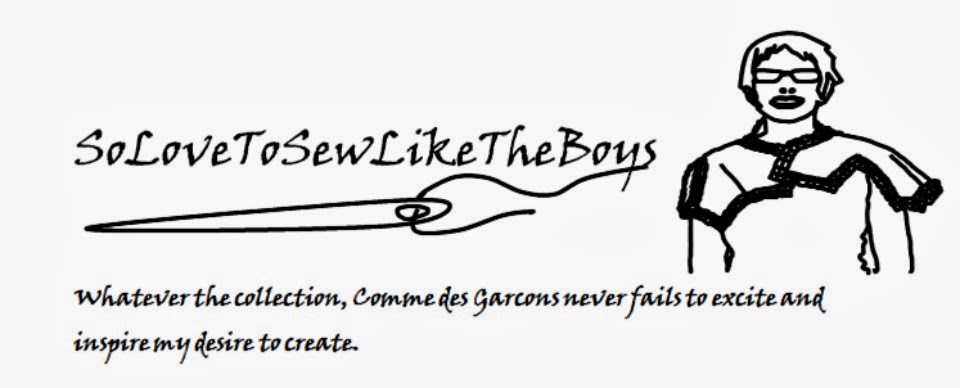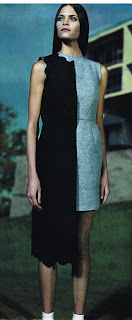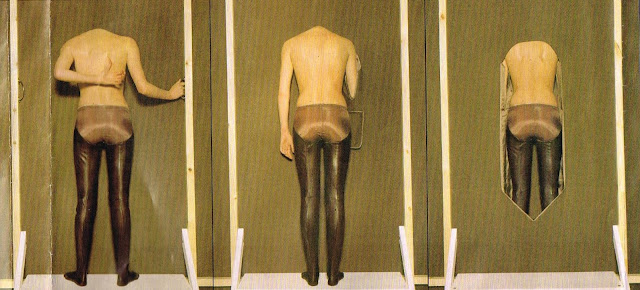Wabi-sabi is an interesting Japanese aesthetic concept about finding beauty in the imperfection and profundity in nature which helps one to accept the cycle of growth, decay and death.
And wabi-sabi has connotations with Rei Kawakubo and Comme des Garcons.
A beautiful book on this subject was written by Leonard Koren in 1994. Leonard Koren is a new Yorker, who was raised in Los Angeles. He came from an artistic/design/architectural background and in the 80's he began a series of visits to Japan, where he totally enveloped the aesthetic of Wabi-Sabi.
"Wabi-sabi is a beauty of things imperfect, impermanent, and incomplete
It is a beauty of things modest and humble.
It is a beauty of things unconventional."
He has written a second book. This time it concerns wabi-sabi within the digital world, but I haven't read it yet, so I can't say much more about it, but I think he has makes comments regard 3D printing.
In the 70s Leonard Koren established a magazine called 'Wet:The Magazine of Gourmet Bathing'...fascinating title..fascinating subject matter. Apparently he is quoted as saying, "If you had to have it explained then it wasn't the magazine for you." There is something very Rei Kawakubo CdG about that statement.
This web site will take you to an interview with Leaonard Koren concerning the magazine. I think it was recorded relatively recently. It is interesting to hear about his concept of 'bath art' that was behind it all. Apparently Matt Groening, Laurie Anderson and David Lynch participated in some of the editions of this magazine.
Bathing is a big thing in Japanese culture (just a side comment of my own.)
The closest English translation of wabi-sabi is "rustic", which is the first impression a lot of people have when they see a wabi-sabi expression for the first time.
Wabi conjures up a philosophy of a reclusive way of life, be free from worldly concerns, which can bring a connection with poverty.
Sabi is a more objective concern which connects to the fleeting nature of material objects.
This website provides a very good summary of the wabi-sabi concept. One of its statements being,
So, what about this seldom articulated, yet intuitively understood wabi-sabi, and Rei Kawakubo...
Harold Koda, a highly regarded figure of the New York fashion world, wrote an essay in 1985 titled, "Rei Kawakubo and the Aesthetic of Poverty". Koda stated that a poor aesthetic, found in wabi-sabi, was within Rei Kawakbubo's Comme des Garcons collections. RK pioneered a form of "dressing poor". The CdG S/S 1982 collection was titled Destroy, and it expressed creativity through destruction. Images of poverty, ruin or decay were a strong element of this collection. Seams were shredded/slashed, colours were dark/sombre, fabrics were tattered/torn, hems uneven...it all hinted of poverty, and connected with the humble, the flawed and the discarded.

A lot of layer over layer, and great flapping coats with frayed edges.
It blew the Western Haute Couture fashion world away!
Many nicknamed these early collections "Hiroshima Chic" or "Hiroshima bag lady look".
RK is reported as describing the New York bag lady as a kind of muse, her "ideal woman to dress". Kate Lousie Rhodes added, "who better represents the loneliness, poverty and self-sufficiency so valued in wabi-sabi."
An evocative image of a New York bag lady.
I am interested in how the above image bears a strong relationship to this photo of a garment from the CdG A/W 2010 collection, which RK referred to as "Inside Decoration"
That layered "bag lady" look is still popular, and very effective in the colder climes.

More images of what some saw as CdG's bag lady ragged look.
I have always loved the fingerless glove look RK encouraged in her earlier collections.
Leonard Koren made an interesting comment on 'Material Qualities of Wabi-Sabi'
"irregular. Things wabi-sabi are indifferent to conventional good taste. Since we already know what the "correct" design solutions are, wabi-sabi thoughtfully offers the "wrong" solutions. As a result, things wabi-sabi often appear odd, misshapen, awkward, or what many people would consider ugly. Things wabi-sabi may exhibit the effects of accident, like a broken bowl glued back together again. Or they may show the result of just letting things happen by chance, like the irregular fabrics that are created by intentionally sabotaging the computer program of a textile loom."
The comment was accompanied by a close up of this famous CdG sweater from the 1982 collection.
This sweater was created by the loosening of a screw here/there on the loom, creating moth holes or as RK described it, a "lace" feature.
"The machines that make fabric are more and more making uniform, flawless textures. I like it when something is off - not perfect. Hand weaving is the best way to achieve this. Since this isn't always possible, we loosen a screw of the machines here and there so they can't do exactly what they're supposed to do." (Rei Kawakubo, reported in Leonard Koren's 'New Fashion Japan 1984)
She was also keen on "distressing material", by way of shrinking, stretching, over-dyeing or bleaching it to give an appearance of age and wear. Coarse wool and rayons, which were usually discarded in high fashion,were often used.
A S/S '83, off-white cotton jersey blouse with cotton ribbon applique and a washed white patchwork dress of sheeting and rayon satin. Another one of the garments that gained the phrase "ragged look". So many of these garments expressed wabi-sabi, that beauty of conscious destitution.
Rei Kawakubo continued with many of these distressed concepts after the 80's. This dress has always fascinated me.
It comes from the A/W 1994 collection known as 'Metamorphosis'.
The dress has been made to look as if it's been worn for years. The loose part was twisted, bundled up and sewn together into a huge lump, then a shrunk effect was given to the fabric. The fabric becomes worn and yarn has come loose, which creates an amazing product.
Rei Kawakubo collaborated with Cindy Sherman on the ad campaign for this collection, and here is the amazing result produced this particular dress.
Astounding, isn't it.
RK also employed a wabi-sabi concept to her fabulous Mayfair London store, 'Dover Street Market'.
This is the counter. It is such a wonderful mis-match of raw wood, corrugated iron, and colour. RK's concept for the store was to create "an ongoing atmosphere of strong and beautiful chaos". Sounds a wabi-sabi ideal to me.
When Rei Kawakubo was presenting her concepts to the Western fashion world...very loose fitting, wide cowl necks, etc....
I was getting into Issey Miyake via Vogue Patterns.
He too, was delivering loose fitting, sombre dark colours, cool cowl necks & waists, and wonderful rough textures...
and "great flapping coats"...my wonderful Issey Miyake coat (I made it twice)
RK also employed a wabi-sabi concept to her fabulous Mayfair London store, 'Dover Street Market'.
This is the counter. It is such a wonderful mis-match of raw wood, corrugated iron, and colour. RK's concept for the store was to create "an ongoing atmosphere of strong and beautiful chaos". Sounds a wabi-sabi ideal to me.
When Rei Kawakubo was presenting her concepts to the Western fashion world...very loose fitting, wide cowl necks, etc....
I was getting into Issey Miyake via Vogue Patterns.
He too, was delivering loose fitting, sombre dark colours, cool cowl necks & waists, and wonderful rough textures...
and "great flapping coats"...my wonderful Issey Miyake coat (I made it twice)
On the first lot of Issey patterns I purchased, this statement was printed:
"ISSEY MIYAKE leads a vital vanguard of Japanese designers in creating contemporary fashions of brilliant originality. His East/West exhilaration gives your fashion life a fresh aesthetic dimension."
So true,as far as I was concerned.
 |
| A lovely CdG jacket, with that aesthetic touch of wabi-sabi. Frayed edges, a worn effect and a dull mud brown colour |
 |
| My wabi-sabi CdG inspired sweater. I used the selvedge 'cos it had a cool "tattery" edge, cut in such a way to give it a loose fit and drape.. |
RK's design concept of establishing a look of aged and flawed items was also delivered to her accessories. Apparently there was a great photo of a pair of CdG boots,which conjured up the painting of Vincent Van Gogh's 1886 'Shoes'.
 |
| These are not necessarily those particular boots, but they do come from CdG's 80's era, and are described as asymmetrical, which is sort of interesting in itself. |
VVG's 'Shoes', which are boots.
Geoffrey Batchen, who wrote 'What of Shoes: Van Gogh and Art History', stated that Vincent bought the shoes, freshly polished at a flea market, but because they were "lacking in fantasy", he wore them during a long walk in the rain so that once covered in mud they appeared more interesting. Batchen believes this is an example of a desire to identify with a person of a lower social class.
My boots- which, I feel, express an element of that aged aesthetic.
I love the look.
In my previous blog I introduced Arabelle Sicardi, 'fashion pirate', wonderful young lady, check out her take on wabi-sabi, it's a good synopsis, however the video doesn't play.
Earlier on I quoted Leonard Koren "Things wabi-sabi may exhibit the effects of accident, like a broken bowl glued back together again."
I have always loved this image
Here are some of my special possessions, which I think show aspects of wabi-sabi.
They display irregularity, earthy colour, earthy shape. I now think, I can take a less "possessive" approach to these possessions, because if there is a breakage of any sort, it's not the end of their beauty. I can glue it back together and it will still possess an aesthetic to appreciate.
Sort of liberating in a way.
In any discussion about wabi-sabi, the poetic form 'haiku' enters the conversation. A haiku is a short poem in the pattern of 5-7-5 syllables.
The great haiku-master Matsuo Basho (1644-1694)
The great haiku-master Matsuo Basho (1644-1694)
is said to embody wabi-sabi. He travelled Japan with very few possessions, stayed in simple accommodation, appreciated nature and the everyday situations he found himself in. He yearned for a
simple life. Observing nature's seasonal dramas, like an autumn leaf floating down a stream, reminded him that life is fleeting.
Sadly, I part from you;
Like a clam torn from its shell,
I go, and autumn too.
(1689)
(1689)
fabric leaf in bowl
conjure up gentle image
earth and decay.
My haiku tee shirt
and my haiku for Rei Kawakubo
thank you Rei, you are inspiration.
SLTSLTBsigning off concerning wabi-sabi.










































































